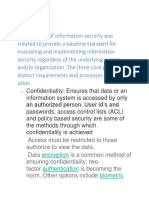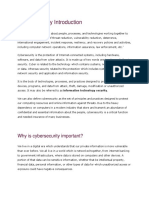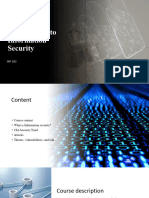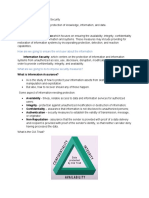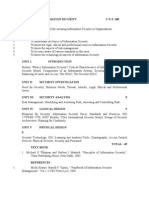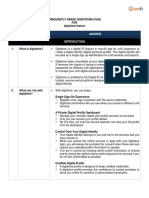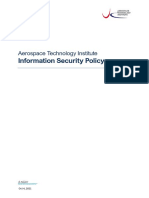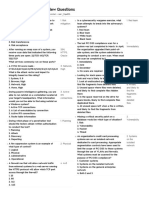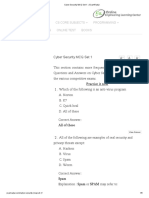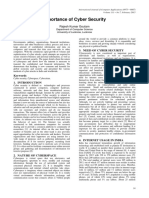L1: Security Principles
Module 1 Understand the Security Concepts of Information
Assurance
Domain D1.1.1, D1.1.2, D1.1.3, D1.1.4, D1.1.5, D1.1.6
Confidentiality
It relates to permitting authorized access to information, while at the same
time protecting information from improper disclosure. Difficulties to achieve
confidentiality are related to: many users are guests or customers, and it is
not clear if the access comes from a compromised machine or vulnerable mobile
application. To avoid those difficulties, security professionals must regulate
access, permitting access to authorized individuals, for that protecting the data
that needs protection.
Data that needs protections is also known as PII or PHI. PII stands for
Personally Identifiable Information and it is related to the area of confidentiality
and it means any data that could be used to identify an individual. PHI
stands for Protected Health Information and it comprehends information about
one’s health status, and classified or sensitive information, which includes trade
secrets, research, business plans and intellectual property.
Related to confidentiality is the concept sensitivity a measure of the im-
portance assigned to information by its owner, or the purpose of denoting
its need for protection. Sensitive information is information that if improp-
erly disclosed (confidentiality) or modified (integrity) would harm an organiza-
tion or individual. In many cases, sensitivity is related to the harm to external
stakeholders; that is, people or organizations that may not be a part of the or-
ganization that processes or uses the information.
Threat related to confidentiality are:
1. Snooping involves gathering information that is left out in the open. Clean
desk policies protect against snooping.
2. Dumpster diving also looking for sensitive materials, but in the dumpster,
a paper shredding protects against it.
3. Eavesdropping occurs when someone secretly listen to a conversation,
and it can be prevent with rules about sensitive conversations
4. Wiretapping is the electronic version of eavesdropping, the best way
against that is using encryption to protect the communication.
5. Social Engineering, the best defense is educate users to protect them
against social engineering.
1
�Integrity
It is the property of information whereby it is recorded, used and maintained in a
way that ensures its completeness, accuracy, internal consistency and usefulness
for a stated purpose, which can be applied to information or data, system
and process for business operations, organizations, people and their
actions. Furthermore, restrict to data integrity, it is an assurance that data has
not been altered in an unauthorized manner, covering data in storage, during
processing, and while in transit.
Consistency is another concept related to integrity and requires that all in-
stances of the data be identical in form, content and meaning. When related to
system integrity, it refers to the maintenance of a known good configuration and
expected operational function as the system processes the information. Ensur-
ing integrity begins with an awareness of state, which is the current condition
of the system. Specifically, this awareness concerns the ability to document
and understand the state of data or a system at a certain point, creating a
baseline. A baseline, which means a documented, lowest level of security con-
figuration allowed by a standard or organization, can refer to the current state
of the information—whether it is protected.
To preserve that state, the information must always continue to be protected through
a transaction. Going forward from that baseline, the integrity of the data
or the system can always be ascertained by comparing the baseline with the
current state. If the two match, then the integrity of the data or the system is
intact; if the two do not match, then the integrity of the data or the system has
been compromised. Integrity is a primary factor in the reliability of information
and systems. The need to safeguard information and system integrity may
be dictated by laws and regulations. Often, it is dictated by the needs of the
organization to access and use reliable, accurate information.
1. Unauthorized modification attacks make changes without permission. The
best way to protect against that is the least privilege principle.
2. Impersonation attacks pretend to be someone else. User education pro-
tects against impersonation attack.
3. Man-In-The-Middle (MITM) attacks place the attacker in the middle of
a communication session, monitoring everything that’s occurring.
4. Replay attacks eavesdrop on logins and reuse the captured credentials.
To both MiTM and Replay attacks the best approach is encryption.
Availability
It means that systems and data are accessible at the time users need them.
It can be defined as timely and reliable access to information and the ability
to use it, and for authorized users, timely and reliable access to data and infor-
mation services. The core concept of availability is that data is accessible to
2
�authorized users when and where it is needed and in the form and
format required. This does not mean that data or systems are available 100%
of the time. Instead, the systems and data meet the requirements of the busi-
ness for timely and reliable access. Some systems and data are far more
critical than others, so the security professional must ensure that the ap-
propriate levels of availability are provided. This requires consultation
with the involved business to ensure that critical systems are identified and avail-
able. Availability is often associated with the term criticality, which means a
measure of the degree to which an organization depends on the information or
information system for the success of a mission or of a business function (NIST
SP 800-60), because it represents the importance an organization gives to data
or an information system in performing its operations or achieving its mission
1. Denial of Service can be mitigated using firewalls to block unauthorized
connections
2. Power outages can be mitigated using redundant power and generators
3. Hardware failures can be mitigated using redundant components
4. Destruction can be mitigated using backups
5. Service outages
Three steps to gain access, known as triple A, which means Authen-
tication, Authorization, Accounting
Identification Consist of making a claim of identity
Authentication When users have stated their identity, it is necessary to
validate that they are the rightful owners of that identity. This pro-
cess of verifying or proving the user’s identification is known as authentication,
which means in another terms access control process validating that the iden-
tity being claimed by a user or entity is known to the system, by comparing one
(single-factor or SFA) or more (multi-factor authentication or MFA) factors of
authentication. Simply put, authentication is a process to prove the identity of
the requestor.
There are three common methods of authentication:
• Something you know: Passwords or paraphrases
• Something you have: Tokens (NISTIR 7711), memory cards, smart cards
• Something you are: Biometrics , measurable characteristics
Methods of Authentication There are two types of authentication. Using
only one of the methods of authentication stated previously is known as single-
factor authentication (SFA). Granting users access only after successfully
demonstrating or displaying two or more of these methods is known as multi-
factor authentication (MFA).
Common best practice is to implement at least two of the three com-
mon techniques for authentication:
3
� • Knowledge-based
• Token-based
• Characteristic-based
Knowledge-based authentication uses a passphrase or secret code to differ-
entiate between an authorized and unauthorized user. If you have selected
a personal identification number (PIN), created a password or some other
secret value that only you know, then you have experienced knowledge-based
authentication. The problem with using this type of authentication alone is
that it is often vulnerable to a variety of attacks. For example, the help desk
might receive a call to reset a user’s password. The challenge is ensuring that
the password is reset only for the correct user and not someone else pretending
to be that user. For better security, a second or third form of authentication
that is based on a token or characteristic would be required prior to resetting
the password. The combined use of a user ID and a password consists of two
things that are known, and because it does not meet the requirement of using
two or more of the authentication methods stated, it is not considered MFA.
Password
• Password length requirements set a minimum number of chars
• Password complexity requirements describe the types of characters that
must be included
• Password expiration requirements force password changes. Nowadays,
that requirement isn’t used, companies change to an approach where force
password change is required when there is any evidence that the password
has been compromised.
• Password history requirements prevent password reuse.
• Provide a way to change the password quickly and easily.
• Encourage users to not reuse the same password across multiple sites
• Password managers facilitate the use of strong, unique passwords
Authorization Ensuring that an action is allowed.
Accounting Its maintains logs of activity
Non-repudiation
Non-repudiation is a legal term and is defined as the protection against an in-
dividual falsely denying having performed a particular action. It provides the
capability to determine whether a given individual took a particular action, such
as created information, approved information or sent or received a message.
In today’s world of e-commerce and electronic transactions, there are oppor-
tunities for the impersonation of others or denial of an action, such
as making a purchase online and later denying it. It is important that all
4
�participants trust online transactions. Non-repudiation methodologies en-
sure that people are held responsible for transactions they conducted.
Base Concepts
1. Authorization: the right or a permission that is granted to a system entity
to access a system resource
2. Integrity: the property that data has not been altered in an unauthorized
manner
3. Confidentiality: the characteristic of data or information when it is not
made available or disclosed to unauthorized persons or process
4. Privacy: the right of an individual to control the distribution of informa-
tion about themselves
5. Availability: Ensuring timely and reliable access to and use of information
by authorized users
6. Non-repudiation: The inability to deny taking an action, such as sending
an email message
7. Authentication: Access control process that compares one or more factors
of identification to validate that the identity claimed by a user or entity
is known to the system
Privacy
Privacy is the right of an individual to control the distribution of in-
formation about themselves. While security and privacy both focus on the
protection of personal and sensitive data, there is a difference between them.
With the increasing rate at which data is collected and digitally stored across all
industries, the push for privacy legislation and compliance with existing policies
steadily grows. In today’s global economy, privacy legislation and regulations
on privacy and data protection can impact corporations and industries regard-
less of physical location. Global privacy is an especially crucial issue
when considering requirements regarding the collection and security
of personal information. There are several laws that define privacy and
data protection, which periodically change. Ensuring that protective security
measures are in place is not enough to meet privacy regulations or to protect
a company from incurring penalties or fines from mishandling, misuse, or im-
proper protection of personal or private information. An example of a law with
multinational implications is the European Union’s General Data Protection
Regulation (GDPR) which applies to all organizations, foreign or domestic, do-
ing business in the EU or any persons in the EU. Companies operating or doing
business within the United States may also fall under several state legislations
that regulate the collection and use of consumer data and privacy. Likewise,
member nations of the EU enact laws to put GDPR into practice and sometimes
add more stringent requirements. These laws, including national- and state-level
laws, dictate that any entity anywhere in the world handling the private data of
people in a particular legal jurisdiction must abide by its privacy requirements.
5
�As a member of an organization’s data protection team, you will not be required
to interpret these laws, but you will need an understanding of how they apply
to your organization.
Module 2 Understand the risk management process
Domain D1.2.1, D1.2.2
Risks and security-related issues represent an ongoing concern of businesses
as well as the field of cybersecurity. Assessing and analyzing risk should be a
continuous and comprehensive exercise in any organization. As a member
of an organization’s security team, you will work through risk assessment,
analysis, mitigation, remediation and communication.
Risk is a measure of the extent to which an entity is threatened by a potential
circumstance or event. It is often expressed as a combination of: the adverse
impacts that would arise if the circumstance or event occurs, and the
likelihood of occurrence.
Information security risk reflects the potential adverse impacts that result from
the possibility of unauthorized access, use, disclosure, disruption, modification
or destruction of information and/or information systems. This definition rep-
resents that risk is associated with threats, impact and likelihood, and
it also indicates that IT risk is a subset of business risk.
Matrix: Probability X Impact generates four possible combinations:
1. low probability, low impact
2. low probability, high impact
3. high probability, low impact
4. high probability, high impact
Risk Management Terminology
• An asset is something in need of protection because it has value to the
organization. It could be a tangible asset or intangible, such as informa-
tion.
• A vulnerability is a gap or weakness in an organization’s protection of
its valuable assets, including information. (NIST SP 800-30). A vulnera-
bility is an inherent weakness or flaw in a system or component, which, if
triggered or acted upon, could cause a risk event to occur. An organiza-
tion’s security team strives to decrease its vulnerability. To do so, they
view their organization with the eyes of the threat actor, asking
themselves, “Why would we be an attractive target?” The answers
might provide steps to take that will discourage threat actors, cause them
to look elsewhere or simply make it more difficult to launch an attack suc-
cessfully. Managing vulnerabilities starts with one simple step:
Learn what they are.
6
� • A threat is something or someone that aims to exploit a vulnerability to
gain unauthorized access. A threat is a person or thing that takes action
to exploit (or make use of) a target organization’s system vulnerabilities,
as part of achieving or furthering its goal or objectives.
• Likelihood, when determining an organization’s vulnerabilities, the secu-
rity team will consider the probability, or likelihood , of a poten-
tial vulnerability being exploited within the construct of the or-
ganization’s threat environment. Likelihood of occurrence is a
weighted factor based on a subjective analysis of the probabil-
ity that a given threat or set of threats is capable of exploiting a
given vulnerability or set of vulnerabilities.
Finally, the security team will consider the likely results if a threat is realized and
an event occurs. Impact is the magnitude of harm that can be expected to result
from the consequences of unauthorized disclosure of information, unauthorized
modification of information, unauthorized destruction of information, or loss of
information or information system availability.
Think about the impact and the chain of reaction that can result when an
event occurs by revisiting the pickpocket scenario: Risk comes from the
intersection of those three concepts.
Risk Identification
In the world of cyber, identifying risks is not a one-and-done activity. It’s
a recurring process of identifying different possible risks, characterizing them
and then estimating their potential for disrupting the organization.
Takeaways to remember about risk identification: * Identify risk to communi-
cate it clearly. * Employees at all levels of the organization are responsible for
identifying risk. * Identify risk to protect against it.
As a security professional, you are likely to assist in risk assessment at a system
level, focusing on process, control, monitoring or incident response and
recovery activities. If you’re working with a smaller organization, or one that
lacks any kind of risk management and mitigation plan and program, you might
have the opportunity to help fill that planning void.
Risk Assessment
Risk assessment is defined as the process of identifying, estimating and
prioritizing risks to an organization’s operations (including its mission,
functions, image and reputation), assets, individuals, other organizations
and even the nation. Risk assessment should result in aligning (or associat-
ing) each identified risk resulting from the operation of an information
system with the goals, objectives, assets or processes that the organi-
zation uses, which in turn aligns with or directly supports achieving
the organization’s goals and objectives. A risk assessment can prioritize
7
�items for management to determine the method of mitigation that best suits
the assets being protected. The result of the risk assessment process is of-
ten documented as a report or presentation given to management
for their use in prioritizing the identified risk(s). This report is pro-
vided to management for review and approval. In some cases, management
may indicate a need for a more in-depth or detailed risk assessment performed
by internal or external resources.
Risk Treatment
Risk treatment relates to making decisions about the best actions to
take regarding the identified and prioritized risk. The decisions made
are dependent on the attitude of management toward risk and the availability —
and cost — of risk mitigation. The options commonly used to respond to risk
are:
• Avoidance: It is the decision to attempt to eliminate the risk en-
tirely. This could include ceasing operation for some or all of the activities
of the organization that are exposed to a particular risk. Organization
leadership may choose risk avoidance when the potential impact
of a given risk is too high or if the likelihood of the risk being
realized is simply too great.
• Acceptance: Risk acceptance is taking no action to reduce the like-
lihood of a risk occurring. Management may opt for conducting the
business function that is associated with the risk without any further
action on the part of the organization, either because the impact or
likelihood of occurrence is negligible, or because the benefit is more than
enough to offset that risk.
• Mitigation: Risk mitigation is the most common type of risk man-
agement and includes taking actions to prevent or reduce the
possibility of a risk event or its impact. Mitigation can involve re-
mediation measures, or controls, such as security controls, estab-
lishing policies, procedures, and standards to minimize adverse
risk. Risk cannot always be mitigated, but mitigations such as safety
measures should always be in place.
• Transfer: Risk transference is the practice of passing the risk to
another party, who will accept the financial impact of the harm resulting
from a risk being realized in exchange for payment. Typically, this is an
insurance policy.
Base Concepts
• Mitigation: Taking action to prevent or reduce the impact of an event
• Acceptance: Ignoring the risks and continuing risky activities
8
� • Avoidance: Ceasing the risky activity to remove the likelihood that an
event will occur
• Vulnerability: An inherent weakness or flaw
• Asset: Something of value that is owned by an organization, including
physical hardware and intellectual property
• Threat: A person or an entity that deliberately takes actions to exploit a
target
• Transference: Passing risk to a third party
Risk Priorities
When risks have been identified, it is time to prioritize and analyze core risks
through qualitative risk analysis and/or quantitative risk analysis. This is nec-
essary to determine root cause and narrow down apparent risks and core
risks. Security professionals work with their teams to conduct both qualitative
and quantitative analysis.
Understanding the organization’s overall mission and the functions that sup-
port the mission helps to place risks in context, determine the root
causes and prioritize the assessment and analysis of these items. In most
cases, management will provide direction for using the findings of the risk as-
sessment to determine a prioritized set of risk-response actions.
One effective method to prioritize risk is to use a risk matrix, which helps
identify priority as the intersection of likelihood of occurrence and im-
pact. It also gives the team a common language to use with management when
determining the final priorities. For example, a low likelihood and a low im-
pact might result in a low priority, while an incident with a high likelihood and
high impact will result in a high priority. Assignment of priority may relate to
business priorities, the cost of mitigating a risk or the potential for loss if an
incident occurs.
Decision Making Based on Risk Priorities
When making decisions based on risk priorities, organizations must evaluate the
likelihood and impact of the risk as well as their tolerance for different sorts of
risk. A company in Hawaii is more concerned about the risk of volcanic
eruptions than a company in Chicago, but the Chicago company will
have to plan for blizzards. In those cases, determining risk tolerance is up
to the executive management and board of directors. If a company chooses to
ignore or accept risk, exposing workers to asbestos, for example, it puts the
company in a position of tremendous liability.
Risk Tolerance
The perception management takes toward risk is often likened to the entity’s
appetite for risk. How much risk are they willing to take? Does manage-
ment welcome risk or want to avoid it? The level of risk tolerance varies across
9
�organizations, and even internally: Different departments may have different
attitudes toward what is acceptable or unacceptable risk.
Understanding the organization and senior management’s attitude toward risk
is usually the starting point for getting management to take action regarding
risks. Executive management and/or the Board of Directors determines what
is an acceptable level of risk for the organization. Security professionals aim to
maintain the levels of risk within management’s limit of risk tolerance.
Often, risk tolerance is dictated by geographic location. For example, companies
in Iceland plan for the risks that nearby volcanoes impose on their business.
Companies that are outside the projected path of a lava flow will be at a lower
risk than those directly in the path’s flow. Similarly, the likelihood of a power
outage affecting the data center is a real threat in all areas of the world. In
areas where thunderstorms are common, power outages may occur more than
once a month, while other areas may only experience one or two power outages
annually. Calculating the downtime that is likely to occur with varying lengths
of downtime will help to define a company’s risk tolerance. If a company has
a low tolerance of the risk of downtime, they are more likely to invest in a
generator to power critical systems. A company with an even lower tolerance
for downtime will invest in multiple generators with multiple fuel sources to
provide a higher level of assurance that the power will not fail.
Module 3 Understand Security Control
Domain D1.3.1, D1.3.2, D1.3.3
What are security controls? (FIBS PUB 199)
Security controls pertain to the physical, technical and administra-
tive mechanisms that act as safeguards or countermeasures prescribed
for an information system to protect the confidentiality, integrity
and availability of the system and its information. The implementation
of controls should reduce risk, hopefully to an acceptable level.
• Physical control: it addresses process-based security needs using physical
hardware devices, such as badge readers, architectural features of
buildings and facilities, and specific security actions to be taken
by people. They typically provide ways of controlling, directing or pre-
venting the movement of people and equipment throughout a specific phys-
ical location, such as an office suite, factory or other facility. Physical
controls also provide protection and control over entry onto the
land surrounding the buildings, parking lots or other areas that
are within the organization’s control. In most situations, physical
controls are supported by technical controls as a means of incorporating
them into an overall security system.
• Technical control: it (also called logical controls) is security controls that
10
� computer systems and networks directly implement. These con-
trols can provide automated protection from unauthorized access or mis-
use, facilitate detection of security violations and support security require-
ments for applications and data. Technical controls can be configuration
settings or parameters stored as data, managed through a software graph-
ical user interface (GUI), or they can be hardware settings done with
switches, jumper plugs or other means. However, the implementation of
technical controls always requires significant operational considerations
and should be consistent with the management of security within the or-
ganization. Many of these will be examined in more depth as we look at
them in later sections in this chapter and in subsequent chapters.
• Administrative control: it (also known as managerial controls) is direc-
tives, guidelines or advisories aimed at the people within the
organization. They provide frameworks, constraints and standards for
human behavior, and should cover the entire scope of the organization’s
activities and its interactions with external parties and stakeholders. It is
vitally important to realize that administrative controls can and should
be powerful, effective tools for achieving information security.
Even the simplest security awareness policies can be an effective control,
if you can help the organization fully implement them through system-
atic training and practice. Many organizations are improving their overall
security posture by integrating their administrative controls into the task-
level activities and operational decision processes that their workforce uses
throughout the day. This can be done by providing them as in-context
ready reference and advisory resources, or by linking them directly into
training activities. These and other techniques bring the policies to a
more neutral level and away from the decision-making of only the senior
executives. It also makes them immediate, useful and operational on a
daily and per-task basis.
Some examples: Administrative: acceptable use policy, emergency operations
procedures, employee awareness training Physical: Badge reader, stop sign in
parking lot, door lock Technical: access control list
Module 4 Understand Governance and Elements and Pro-
cess
Domain D1.5.1, D1.5.2, D1.5.3, D1.5.4
Governance Elements
When leaders and management implement the systems and structures that the
organization will use to achieve its goals, they are guided by laws and reg-
ulations created by governments to enact public policy. Laws and
regulations guide the development of standards, which cultivate poli-
cies, which result in procedures.
11
� • Procedures are the detailed steps to complete a task that support de-
partmental or organizational policies.
• Policies are put in place by organizational governance, such as execu-
tive management, to provide guidance in all activities to ensure that the
organization supports industry standards and regulations.
• Standards are often used by governance teams to provide a framework
to introduce policies and procedures in support of regulations.
• Regulations are commonly issued in the form of laws, usually from gov-
ernment (not to be confused with governance) and typically carry financial
penalties for noncompliance.
Regulations -> Standards -> Policies -> Procedures
Module 5 Understand (ISC)² Code of Ethics
12













